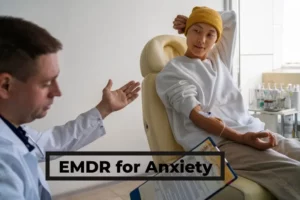Introduction
To illustrate how CBT works with panic disorder, let’s first understand both concepts in detail. CBT, or cognitive behavioral therapy, is one of the most sought-after psychotherapy due to its widely accepted applicability and research. It is known to work particularly well with anxiety disorder.
Panic Disorder is a type of anxiety disorder for which CBT is used. It is a form of psychotherapy. In panic disorder, you suffer from unknown bouts of fear that lead you to have panic attacks frequently. Let’s find out how the panic attacks decrease through CBT below.
CBT For Panic Disorder
For the purpose of understanding how psychotherapy, particularly CBT, helps in dealing with panic disorder. It is important to understand what goes on during a panic disorder that creates difficulties for the individual. Alternatively, we discuss in detail the know-how of CBT below.
What Happens During A Panic Disorder?
In essence, the underlying principle behind CBT works by reducing the frequency of panic attacks. A panic attack refers to a series of bodily reactions as a result of heightened fear or anxiety. These reactions can occur together or separately. The symptoms of panic attacks that occur during panic disorder are:
- Sweating or chills experienced by the body.
- Trembling, shaking or feeling the same.
- Racing heart or pounding of the heart.
- Gastric issues include vomiting, nausea, upset stomach, etc.
- Heavy breathing or difficulty in breathing.
- Feeling faint or unbalanced gait.
- Sudden thoughts of dying and fear of the worst happening.
In addition to the symptoms, in panic disorder, you experience panic attacks frequently and suddenly. These panic attacks are the body’s way of dealing with stress, some kind of excessive worry or change in the environment. CBT works on these triggering thoughts and situations in the environment that lead to a panic attack.
How Does CBT Work for Panic Disorder?
Without a doubt, psychotherapy is established as one of the best forms of interventions for mental health and emotional well-being. Within psychotherapy, CBT is the most sought sub-branch as it has been shown to be effective over a wide range of mental illnesses through scientific research. In relation to anxiety disorders, specifically panic disorder, it has been shown to reduce the frequency of panic attacks.
In essence, CBT combines behavior psychology and cognitive psychology. CBT works on identifying irrational or distressing thoughts that automatically arise and lead to changes in feeling and behavior. In panic disorder, the emphasis is on working with thoughts and feelings that trigger panic attacks and reducing them. Reducing the triggering thoughts helps in changing the body’s reaction to fear and anxiety.
What Is The Most Important Component Of CBT For Panic Disorder?
Compared to other forms of psychotherapy, CBT has specific and structured components. Not only is CBT divided into each session, but it is goal-oriented and can help in reducing concerns systematically. Perhaps the most important component of CBT in relation to panic disorder is challenging triggering thoughts. The triggering thoughts refer to the negative thoughts that lead to feelings of anxiety and fear.
Particularly, if you are suffering from panic disorder, you are more likely to have recurring apprehensions or worrisome thoughts. Moreover, you will be prone to having more scary thoughts, and your mind will make you believe that you are not equipped to deal with stressors. The most important component of CBT is an emphasis on changing such negative thoughts.
As mentioned above, changing the negative thoughts is essential as these thoughts are connected to feelings of fear and behaviors that lead to panic attacks. Panic attacks are bodily responses to danger; negative thoughts in panic disorder can induce these bodily reactions to fear by focusing on negative thoughts.
What Is The CBT Model For Panic Disorder?
Overall, the CBT model for panic disorder is divided on the basis of the constituents of CBT. Altogether, these constituents work on shifting thoughts, developing skills to relax, and reducing the sensitivity of the body to panic attacks. Below, we elaborate on the constituents of CBT.

Cognitive Restructuring
Firstly, cognitive restructuring refers to recording and analyzing negative thoughts and beliefs and changing them. This is done by a combination of homework, thought records and questioning during the therapy. Specifically, cognitive distortions or thoughts that tend to catastrophize the situation, are irrational and lead to unhealthy responses are addressed.
If you have panic disorder, you will be made to recognize the thoughts that are associated with feelings of panic. Moreover, you will learn how your thoughts and beliefs lead to unpleasant feelings and behavior and end in panic attacks.
Relaxation Skills
Secondly, relaxation skills refer to learning ways to relax and provide rest to the mind so that it doesn’t experience excessive anxiety. Along with this, the emphasis is on creating awareness of breathing and employing breathing exercises to shift the mind and body from a panic-like state to normalcy.
During panic attacks, breathing difficulties signal the body and mind that it is in distress. Employing different ways to relax before a panic attack and deep breathing-related exercises can signal to the mind that you are in control and relaxed.
Desensitization Through Exposure
Thirdly, once you have undergone the other two components of CBT, you gradually learn to face panic attacks. This is done in stages or in a graded fashion with progress that isn’t distressing. The exposure to a threatening environment and panic attack reactions are exposed virtually, followed by real-life scenarios and finally the bodily sensations.
Panic attacks in themselves can create apprehension and increase anxiety for further panic attacks. By graded exposure, you learn not to fear panic attacks and rather learn to see them as bodily reactions. Furthermore, you practice how to approach threatening scenarios with calm, reducing the likelihood of panic attacks in the future.
Conclusion
Overall, Cognitive Behavioural Therapy, or CBT, has good effectiveness in addressing panic disorders. This is mainly due to the component of thought restructuring that precedes a panic attack and increases the frequency of panic attacks during panic disorders.
Finally, components of CBT such as restructuring of cognition, breathing-related training, and graded exposure show us the exact mechanism of dealing with panic disorder. It is important to note that CBT should be practiced by a licensed and trained mental health professional only. To reach out to quality mental health professionals, connect to United We Care.
References
[1] A. Pompoli, T. A. Furukawa, O. Efthimiou, H. Imai, A. Tajika, and G. Salanti, “Dismantling cognitive-behaviour therapy for panic disorder: a systematic review and component network meta-analysis,” Psychological Medicine, vol. 48, no. 12, pp. 1945–1953, Jan. 2018, doi: https://doi.org/10.1017/s0033291717003919.
[2] National Institute of Mental Health, “Panic Disorder: When Fear Overwhelms,” www.nimh.nih.gov, 2022. https://www.nimh.nih.gov/health/publications/panic-disorder-when-fear-overwhelms
[3] K. Fenn and M. Byrne, “The key principles of cognitive behavioural therapy,” InnovAiT: Education and Inspiration for General Practice, vol. 6, no. 9, pp. 579–585, 2013, doi: https://doi.org/10.1177/1755738012471029.










